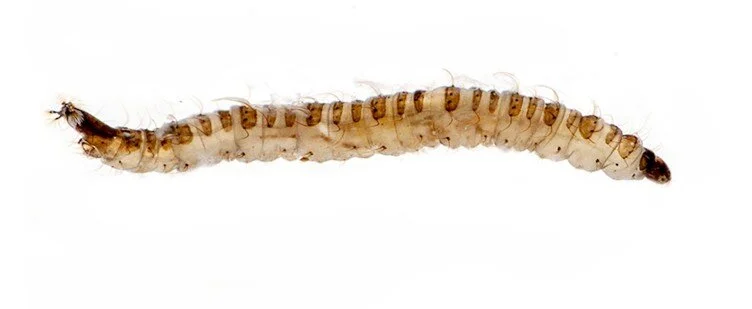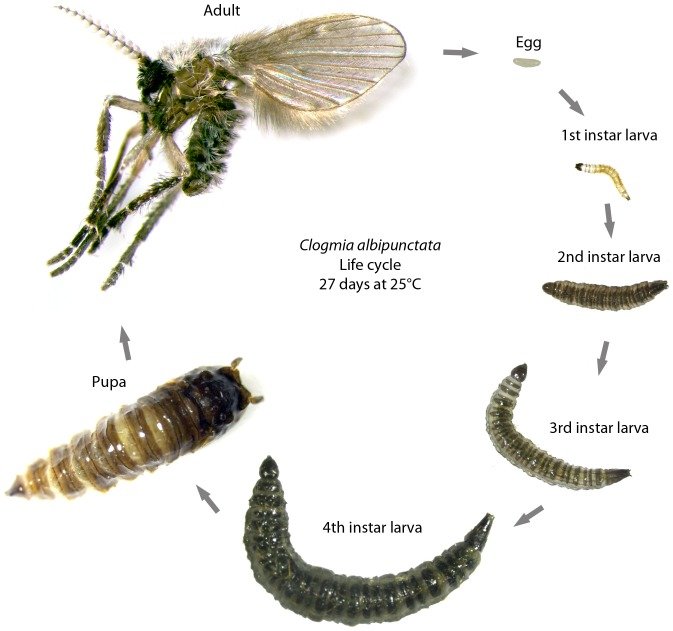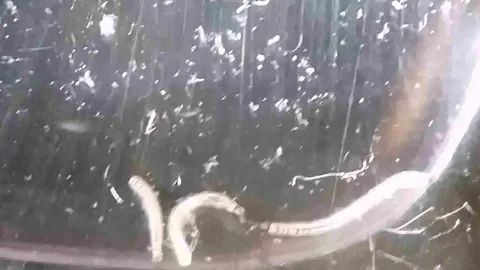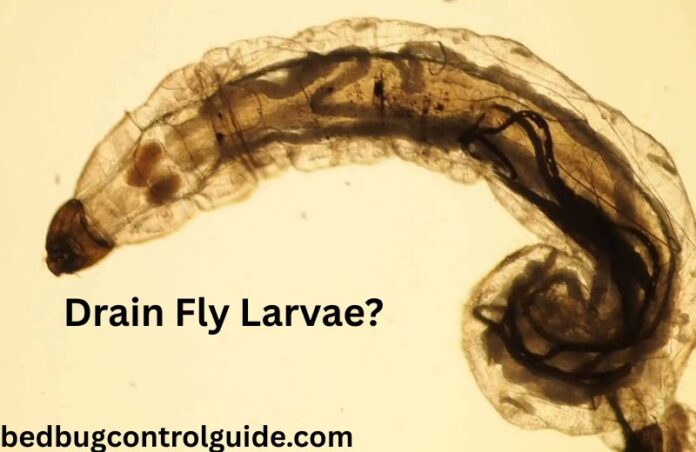Have you noticed small flies buzzing around your sink, shower, or drains? You might be dealing with drain fly larvae. While these pests aren’t dangerous, they can be a nuisance and are often found in the moist environments of your home, particularly near drains and pipes. In this guide, we’ll cover everything you need to know about drain fly larvae in 2025—what they are, how to get rid of them, and how to prevent them from coming back.
What Are Drain Fly Larvae?

Drain fly larvae are the immature stage of drain flies (also known as filth flies or sewer flies). These tiny insects are typically found in the moist, organic matter inside drains, such as grease, soap scum, and food debris. Their larvae are small, creamy-white to grayish, and they thrive in the stagnant water found in drains, sewage systems, and pipes.
Drain fly larvae can also be found in p-traps, garbage disposals, or grease traps, which provide the ideal environment for them to grow. The adult drain flies are fuzzy and moth-like, usually seen flying around sinks, showers, or anywhere near drains.
How would you identify Drain Fly Larvae?
Recognizing drain fly larvae is the first step in identifying if you have a problem. Here are the signs:
- Larvae Size: Drain fly larvae are tiny, usually around 1/4 inch (6mm) long when fully grown.
- Color: They are typically pale white, grayish, or transparent, with a soft, slimy texture.
- Movement: You might spot larvae crawling inside drains or nearby areas where the organic buildup is concentrated.
- Adult Flies: If you see small, moth-like flies near your drain, it’s a sign the larvae have turned into adults.
You may find larvae stuck to the inside walls of your drain, in the standing water, or along the edges of a sink or pipe where the water sits undisturbed for long periods.
These larvae look like tiny worms. They are usually white or cream-colored with segmented bodies. At one end, they have a small breathing tube, which lets them get air while they’re covered in organic matter. They typically grow up to 9mm in length.
Life Cycle

Drain flies go through several stages:
- Egg Stage – A female drain fly lays up to 100 eggs in slimy buildup inside a drain.
- Larva Stage – Eggs hatch into larvae in just 1–2 days. These larvae, also known as drain worms, feed on bacteria and decaying organic material.
- Pupal Stage – After about 10–15 days, larvae form a pupa. This stage lasts 1–2 days.
- Adult Stage – Adult flies emerge and live for about two weeks. The cycle repeats quickly, turning small infestations into much bigger problems.
Want to know about Drain Flies vs Fruit Flies: How to Tell the Difference in 2025
Why Are Drain Fly Larvae a Problem?

Many people don’t realize they have a problem with drain fly larvae until it becomes severe. These worms can cause both health and hygiene issues.
Spread of Bacteria
The buildup they live in contains bacteria, which can be spread to other parts of your home. If these flies make their way to food preparation areas, they could contaminate your food.
Worsen Allergies and Asthma
Dead drain flies and larvae can dry out and become part of the dust in your home. Breathing this, especially for people with asthma or allergies, can trigger symptoms or make them worse.
Persistent Infestations
Because of their short life cycle, drain flies multiply fast. If the larvae are not dealt with, adult flies will keep reappearing, week after week. Read also the post on Do Fruit Flies Bite: How to Identify and Get Rid of Them at House
Read Our Most Recently Published Guides on Termites, Earwigs, Fruit Flies, Ants Control, Baby Termites, Carpenter Ants and Gnats:
- Early Signs of Bed Bugs on Mattress? Explained in 2025
- Skin Early Signs of Bed Bugs? Identification, Prevention
- What do Bed Bug Bites Look Like on Human Skin: Identification, Treatment, and Prevention
- Baby Termites vs Ants? How to Tell the Difference
- How Big are Termites? How to Identify Termites and Treatment
- What Color are Termites? Their Types of Termites
- Fungus Gnats vs Fruit Flies: How to Tell the Difference in 2025
- Do Fruit Flies Bite: How to Identify and Get Rid of Them at House
- Drain Flies vs Fruit Flies: How to Tell the Difference in 2025
- How to Get Rid of Plant Gnats Fast? Prevention and Treatment Tips
- How to Get Rid of Fungus Gnats in House Fast? Fungus Gnats Treatment Tips
How to Get Rid of Drain Fly Larvae
Removing drain fly larvae worms doesn’t have to be difficult. With some simple tools and steps, you can stop them from coming back.
Step 1: Clean the Drains
Start by identifying where the larvae are. The most likely spots are slow or clogged drains. Use a stiff brush to scrub the drain walls and remove the slime.
- Remove the drain cover.
- Scrub the inside of the drain with a stiff brush.
- Pour hot water to rinse away any loose debris.
Step 2: Use Enzymatic Cleaners
Enzyme-based cleaners are very effective for dislodging organic matter that larvae feed on. Pour the cleaner according to the product instructions and allow it to work overnight. Repeat if necessary.
Step 3: Flush with Hot Water
While boiling water is often suggested, use caution. Very hot water can help kill drain fly larvae, but boiling water can also damage older pipes. Pour the hot water down the cleaned drain to remove any remaining debris.
Step 4: Seal Cracks and Gaps
Cracks in pipes or drains provide entry points for flies to lay their eggs. Seal these using waterproof sealant or call a plumber to fix damaged pipes.
Step 5: Call a Professional
If the problem persists, reach out to a pest control professional or plumber. They have advanced tools and treatments to clear infestations and check for serious issues like sewer leaks. Our Latest post Flying Ants vs Termites: Appearance, Behavior & Life Cycle Differences
Conclusion
Drain fly larvae can be more than a nuisance—they can lead to allergies, bacteria spread, and frequent infestations. By keeping your drains clean and fixing any plumbing problems, you can stop them from taking over your home. If the infestation continues, call a professional to handle the issue before it gets worse. Maintaining your plumbing is key to preventing these pests from coming back. Follow Us on Facebook, Pinterest and Twitter for the latest updates.
FAQs
How Do You Get Rid of Fly Larvae?
To get rid of drain fly larvae, clean the drain thoroughly with a stiff brush and use enzyme-based cleaners to remove organic buildup. Rinse with hot water and monitor the drain for any recurring issues.
Does Boiling Water Kill Drain Fly Larvae?
Yes, boiling water can kill drain fly larvae, but it is not a complete solution. Residue left in the pipes can still attract flies to lay eggs. Use hot water as part of a thorough cleaning routine.
Can You Use Baking Soda to Unclog Drains?
Yes! Baking soda is a natural option for unclogging drains and deterring larvae. Sprinkle baking soda into the drain, then pour in vinegar. This creates a foamy chemical reaction that helps break down slime.
Does Vinegar Kill Drain Fly Larvae?
Vinegar is useful for removing organic debris, which limits food sources for larvae. While it won’t kill the larvae directly, it helps clean drains effectively when combined with hot water or baking soda.
How Do I Prevent Drain Fly Larvae?
- Clean your drains weekly by flushing them with hot water.
- Avoid letting food particles, oil, or hair build up in the sink, shower, or bathroom drains.
- Use enzyme cleaners every month to keep pipes clear and reduce organic build-up.
- Regularly inspect and fix leaks or cracks in your plumbing.



